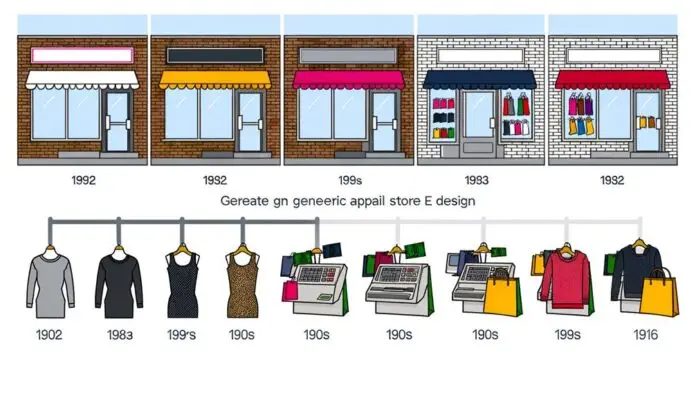One might find it astonishing to discover that Ross Stores, the leading discount retailer in the United States, had a modest beginning with a single store in 1982. The firm has expanded to over 2,000 sites across the country, attributed to a tactical strategy and an unwavering commitment to affordable pricing. Consumers can now purchase name-brand items at markedly lower costs.
As you consider the journey of this retail giant, you'll uncover a narrative of savvy expansions, economic resilience, and the ever-evolving challenge of staying on top in the competitive world of discount retailing.
What's not often discussed, however, is the intricate tapestry of decisions and events that propelled Ross Stores from a local outlet to a household name. Join in exploring the pivotal moments that have defined the trajectory of Ross Stores, and perhaps you'll gain insights into the art of retail that few have fully grasped.
Key Takeaways
- Ross Stores started with a single store in 1982 and expanded rapidly, entering the San Francisco Bay Area market in 1983 and going public in 1985.
- The company focused on internal systems in the late 1980s and then refocused on its off-price retail formula in the 1990s, expanding its product offerings beyond apparel.
- Ross Stores experienced significant growth in the early 2000s, expanding its presence across the United States, entering new markets in the Southeast and Mid-Atlantic regions, and establishing new distribution centers.
- Despite challenges, including the Covid-19 pandemic, Ross Stores has remained resilient and successful, becoming the largest off-price retailer in the United States with over 2,000 locations and annual sales reaching $16.0 billion in recent years.
Foundational Years
In 1982, Bill Isackson, Morris Ross, and Stuart Moldaw laid the foundation for what would become Ross Dress For Less, swiftly launching two stores that fall and setting the stage for rapid expansion beyond California the following year. This trio of visionaries, including Morris Ross, who was a founder of the Mervyns chain alongside Mervin Morris, embarked on an ambitious journey. Their initial opening was a testament to their entrepreneurial spirit and understanding of the retail landscape.
The store in San Bruno was one of the first to welcome shoppers, marking Ross's entry into the San Francisco Bay Area's competitive market. The company's growth strategy was aggressive and well-calculated, spreading its reach from Newark to Pleasanton, and finding a home in Redwood City. You could sense the excitement as each new location opened its doors, with Morris Ross's retail acumen guiding the way.
Only three years after the initial launch, Ross Stores went public with its Initial Public Offering (IPO) in August 1985. This pivotal event, backed by a group of investors who saw the potential in Ross's unique off-price model, was a clear indicator of the company's robust health and the founders' vision coming to fruition.
Expansion and IPO

After its IPO in August 1985, Ross Stores harnessed the power of public investment to fuel its expansion and fortify its infrastructure. The company's decision to go public with its IPO on Nasdaq under the symbol ROST marked a pivotal moment in its history. With the influx of capital, Ross Stores embarked on a journey of accelerated store growth and strategic infrastructure investment.
However, you'll find that the expansion wasn't a relentless forward march. Between 1987 and 1989, Ross Stores slowed down its expansion to concentrate on strengthening management and internal systems. But don't mistake this for a lack of progress. This period of introspection set the stage for a surge in the 1990s, as Ross Stores refocused on their off-price retail formula, expanded their product offerings, and honed in on growing within their existing markets.
By the dawn of the early 2000s, you'd see that Ross Stores had not only increased its number of stores but also ventured into new territories, signaling their first major new market entries. The opening of 12 stores in one go wasn't uncommon, illustrating the company's confidence and the success of its business model.
In 2018, the company ended the year with a whopping 1,483 stores. This number cements Ross Stores as a formidable force in the discount retail space.
Here's a quick glance at their journey:
| Year | Milestone |
|---|---|
| 1985 | Stores went public on Nasdaq |
| 1987-1989 | Focus on management and infrastructure |
| 1990s | Expansion and IPO strategies refined |
| 2000s | Store growth and new market entries |
You can see that Ross Stores' strategic moves post-IPO laid a robust foundation for their compelling story of growth and resilience in the retail industry.
Strategic Restructuring

Turning to the strategic restructuring in the early 1990s, Ross Stores honed its core off-price business strategies to streamline operations and bolster its competitive edge. This pivot wasn't just about trimming the fat; it was a concerted effort to enhance the company's position in the off-price retail market. With a sharp focus on existing markets, Ross Stores aimed to grow from within, improving operating margins and securing a stronghold amid fierce competition.
As part of this strategic shift:
- The company made significant investments in its buying organization, empowering its ability to scoop up the best deals and pass those savings onto you.
- Product offerings expanded, including a broader range of non-apparel items like home accents and bed & bath, to meet your diverse shopping needs.
- By the end of the fiscal year 2000, the strategic restructuring had propelled Ross Stores to new heights, boasting annual sales of $2.7 billion across 409 stores in 17 states and Guam.
Under the leadership of CEO Michael Balmuth, and later when Barbara Rentler took the place at the helm, the company didn't just rest on its laurels. They continued to strengthen the company's ability to serve new markets. This involved setting up additional distribution centers in South Carolina, which ensured that the latest trends and deals reached you faster than ever.
Moreover, the strategic restructuring encompassed prudent investments in management and infrastructure, laying the groundwork for future expansion. With plans to open even more stores, Ross Stores was poised to bring its unique off-price model to shoppers far and wide, reaffirming its commitment to value and variety.
Nationwide Growth

As Ross Stores embarked on its journey of expansion, it rapidly grew from a regional chain to a national retail giant, scaling up to 409 stores by the close of fiscal 2000. This leap marked a significant phase in the department chain's history, as it transitioned from a modest footprint of 121 stores in 16 states with sales of $534 million at the end of fiscal 1986, to a sprawling presence across the United States.
During this period, you'd have witnessed Ross Stores' aggressive nationwide growth strategy. The company not only expanded its number of locations but also entered new markets in the Southeast and Mid-Atlantic regions. They weren't just opening new stores; Ross Stores invested heavily in the infrastructure needed to support such rapid growth, including new distribution centers and systems.
This expansion brought about a remarkable increase in annual sales, with the fiscal year ending totals reaching a whopping $2.7 billion. But Ross Stores didn't stop there. As they moved into the early 2000s, they continued to push boundaries, launching a new brand aimed at a different segment of customers, further diversifying their offerings.
From 2010 to 2014, the Dress for Less slogan became synonymous with affordable fashion as Ross Stores' presence ballooned to 1,091 stores in 33 states, alongside 108 DD's Discounts stores in 8 states, with annual sales hitting $7.9 billion. Your shopping options expanded as Ross Stores made its way into the Midwest market.
Looking at recent years, Ross Stores has set ambitious targets for future growth, planning for a total of 2,400 Ross Dress for Less locations and 600 DD's Discounts stores. Despite the challenges posed by the Covid-19 pandemic, they opened 28 new stores and generated $16.0 billion in sales, adapting to the ever-evolving retail landscape.
New Challenges and Milestones

Despite facing new hurdles, Ross Stores marked significant milestones, adapting its business model to maintain a competitive edge in the dynamic retail industry. You've seen the brand evolve, focusing on its core off-price strategies, and expanding product offerings. In the 2000s, Ross Stores experienced substantial growth, both in annual sales and store count, and you witnessed the brand's strategic expansion into new markets.
- The company launched dds DISCOUNTS, targeting a different customer segment, enriching its retail portfolio.
- Ross Stores entered the Midwest region, a significant move that broadened its national footprint.
- New distribution centers were established to support the growing number of new store openings and dds DISCOUNTS locations.
In the early 2010s, Ross continued to grow, entering new territories and achieving record sales that underscored its fiscal year successes. However, the Covid-19 pandemic presented unprecedented challenges, slowing the pace of expansion. Yet, Ross Stores didn't stand still. It adapted swiftly, remaining committed to its promise of offering brand-name and designer goods at lower prices and preserving the treasure hunt shopping experience that customers cherished.
Your understanding of Ross Stores' journey is deepened by knowing that, despite obstacles, the company has consistently reported strong financial performance. This achievement is reflected in its stature, as Ross Stores is well-recognized by Fortune for its industry standing.
Ross Stores' history is a testament to resilience and adaptability. Even as the retail landscape continues to change, Ross's commitment to its business model and customer experience has allowed it to maintain its status as a leading off-price retailer.
How does the history of Ross Stores relate to real estate investment trusts like Lexington Realty Trust?
Ross Stores’ history of acquiring and developing retail locations ties directly to the real estate investment trusts like Lexington Realty Trust. The symbol of Lexington Realty Trust, LXP, represents a prime example of a REIT that invests in commercial properties, including retail spaces. Ross Stores’ growth is closely linked to the success of REITs like LXP.
Frequently Asked Questions
Are Ross and TJ Maxx Owned by the Same?
No, you're looking at two distinct entities. Ross and TJ Maxx are competitors in discount retailing, each with unique brand strategies and market positioning, reflecting their differences in ownership, expansion tactics, and shopping experience.
What Is the Sister Company of Ross?
DD's Discounts is Ross's sister company, targeting moderate incomes with strategic expansion and distinct geographic footprint, strengthening market positioning and retail differentiation without overlapping Ross's consumer perception. They're not the same entity but share collaborative opportunities.
Why Is Ross Stores so Successful?
Ross Stores thrives by employing an off-price model, offering discounted brands, and ensuring rapid inventory turnover. Their savvy business strategy, tailored to target demographics, smart real estate choices, and focus on customer experience, fuel success.
What Does True Stand for at Ross?
At Ross, "true" embodies their discount philosophy, enhancing brand perception and fostering customer loyalty. Their business model, retail strategy, and pricing tactics prioritize your shopping experience, with a store layout and inventory management that streamline savings.
Conclusion
You've witnessed Ross Stores' remarkable journey from a humble San Bruno shop to the largest off-price retailer in the U.S. With over 2,000 locations, it's clear their strategy to offer top brands at deep discounts resonated with you, the savvy shopper.
Despite market shifts and leadership changes, Ross continues to thrive, proving that a simple, fun shopping experience never goes out of style.
Here's to finding those hidden treasures on the rack!



